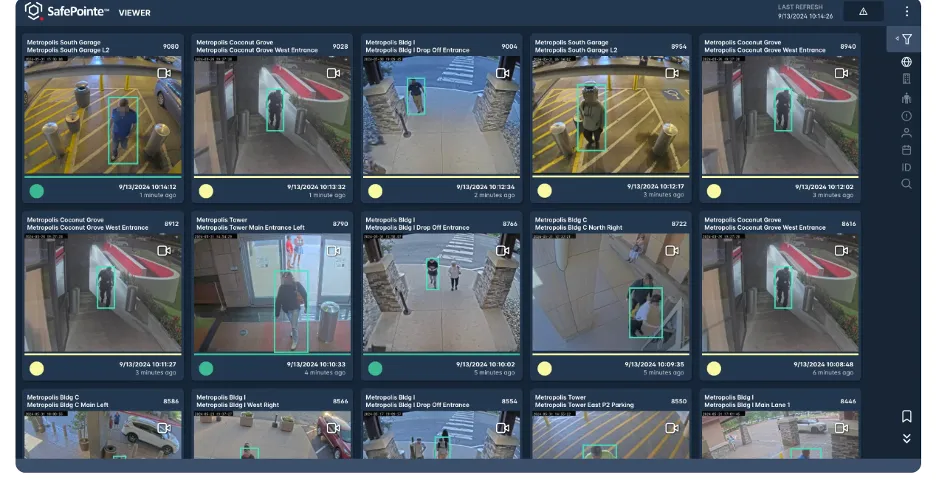At SoundThinking, our mission is to develop transformative public safety and security solutions that help protect lives while creating safer, more welcoming environments. Our SafePointe weapons detection system embodies that vision—blending innovative design, military-grade thinking, and cutting-edge AI to address a critical need in public safety: detecting real threats while minimizing false alarms and screening friction.
From Forward Operating Bases to Commercial Lobby Spaces
SafePointe’s origin story begins not in a corporate R&D lab or tech incubator, but on the frontlines of Iraq and Afghanistan. A U.S. acquisitions officer—armed with both a PhD and a mission to protect military personnel—was tasked with developing a covert perimeter security system that could identify enemy combatants carrying weapons across wide unforgiving territories.
This wasn’t a job for traditional checkpoint systems. The mission called for a solution that was invisible, low-cost, low-maintenance, and accurate. The goal was to detect firearms reliably—without false alarms triggered by environmental noise like wildlife or debris.
After evaluating and discarding conventional approaches like radar, optics, and active sensors, the breakthrough came from a surprisingly elegant idea: using the Earth’s magnetic field. All metallic objects generate a measurable disturbance in this field—known as a “magnetic moment.” By detecting those disturbances passively and without emitting any signals, a system could identify weapons at distance, without requiring the heavy hand of visible intrusive infrastructure.
That principle became the foundation for a new paradigm in threat detection—SafePointe- now developed to meet the modern security needs across civilian venues such as hospitals, schools, casinos, corporate campuses, and transportation hubs.
Passive by Design: The Architectural Advantage
SafePointe is fundamentally different from conventional weapons detection systems and metal detectors that rely on high-frequency energy beams or millimeter-wave emissions to scan individuals. These active systems must beam energy toward a subject to detect concealed items, which often requires checkpoint-style setups and direct line-of-sight that slow foot traffic and erode trust.
In contrast, SafePointe uses passive low-frequency sensors—paired with a 3D camera that captures motion data analysis—to identify weapon threats based on magnetic disturbances. It listens rather than emits. This quiet intelligence is safer for vulnerable populations (e.g., people with pacemakers or pregnant women), and more flexible in how it’s deployed.
Here’s a simple analogy that captures the spirit of weapons detection technologies:
- Passive Detection (SafePointe): Analogous to noticing someone approach on a quiet night by watching their shadow in moonlight—no spotlight, no disruption, just sensing presence through subtle change.
- Active Detection (Conventional Systems): Analogous to flipping on a spotlight to find someone—you see everything in the beam, but also flood the space with light, possibly causing confusion or false alarms.
This passive architecture allows SafePointe to be seamlessly integrated into existing environments—through unobtrusive bollards, planters, or even behind walls—with units spaced 8–10 feet apart. The result: no visible checkpoints, no removal of possessions or wanding, no active signals passing through visitors, smoother traffic flow, less anxiety, and minimal friction.
Detection Without Disruption
Every weapons detection system should be judged on three critical metrics:
- True Positives – Can it reliably detect actual weapons?
- False Positives – Does it avoid mistakenly flagging harmless items?
- Friction – How disruptive is the experience for the people being screened?
SafePointe performs strongly across all three dimensions.
- True Positives: SafePointe uses a combination of magnetic signature data, 3D motion capture, and edge-compute processors to detect concealed weapons—even in crowded or complex environments.
- False Positives: Since our models are continuously trained on an expanding corpus of labeled threat signatures using transfer learning and real-time human-in-the-loop validation, SafePointe can confidently distinguish between a firearm and a laptop, reducing unnecessary alarms.
- Frictionless Experience: No checkpoints. No bottlenecks. No scanning lines. SafePointe operates in the background, screening individuals as they naturally pass by—making it ideal for high-traffic, customer-sensitive locations like hospitals, schools, or casinos.
And the operational impact of fewer false positives is significant. A modest 10% improvement in accuracy over 10,000 entries means 1,000 fewer interruptions—saving time, staff costs, and customer frustration.
The AI/ML Edge: Why AI loves Passive Systems
The future of threat detection lies in intelligent learning—and SafePointe is built for it.
Unlike systems that rely on a single scan and limited data, SafePointe’s passive approach collects rich, multi-dimensional inputs—magnetic moment, velocity and location. Recent breakthroughs in AI-architecture – especially transformer models- thrive on multi-modal data and excel at identifying subtle patterns across complex data streams.
As the data capture of weapons signatures increases, SafePointe becomes increasingly capable of identifying threats. The system doesn’t just detect—it learns, adapts, and improves in real time.
A Smarter Approach to Safety
SafePointe is more than a product—it’s a philosophy. One that embraces smarter design, invisible security, and AI-driven adaptability. It’s grounded in real-world insight, powered by modern technology, and shaped by a deep understanding of human experience that values the protection dignity as much as it as it protects lives .
As we continue to develop SafePointe, our north star remains clear: high detection accuracy, low false alarms, and a zero-friction experience for the public.
Explore SafePointe’s Passive Screening and Assess the Impact on Your Security Operations





